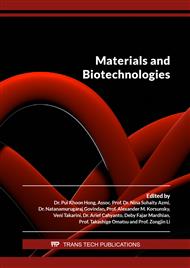p.23
p.31
p.37
p.49
p.55
p.61
p.69
p.79
p.87
Impact of Different PAA Solid Content Applied to Polyimide-Based Resistive Random Access Memory
Abstract:
This study investigated the impact of different Polyamic Acid (PAA) solid content on Polyimide (PI) film precursors, adjusting the molecular chain density after dehydration and cyclization to improve the operating voltage and leakage current of resistive random access memory (RRAM). This work modulated 1.5%, 5%, and 15% PAA solutions to form PI film as a resistance switching layer. After modulating the molecular chain density in the PI film, the goal is to improve the device’s operating characteristics. According to the result, the PI film with a higher concentration can achieve a lower operating electric field and reduce the leakage current, improving operational stability and reliability.
Info:
Periodical:
Pages:
55-59
Citation:
Online since:
August 2022
Authors:
Keywords:
Price:
Сopyright:
© 2022 Trans Tech Publications Ltd. All Rights Reserved
Share:
Citation:



